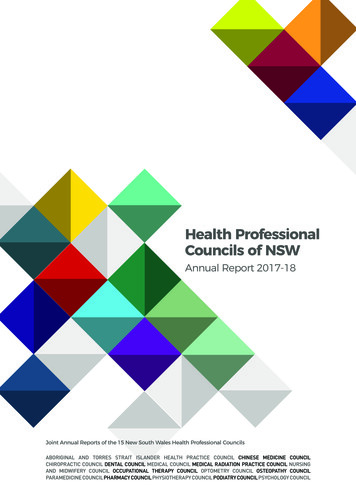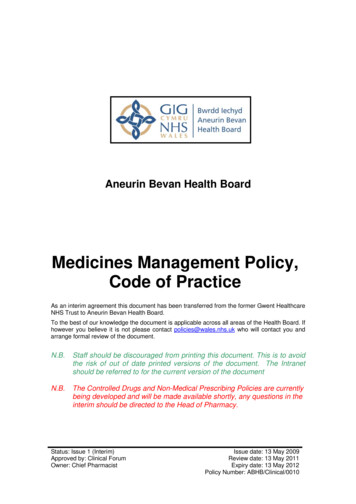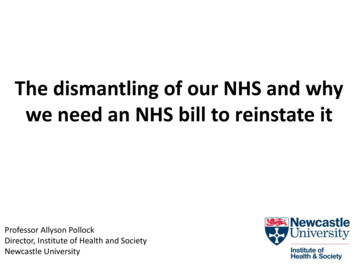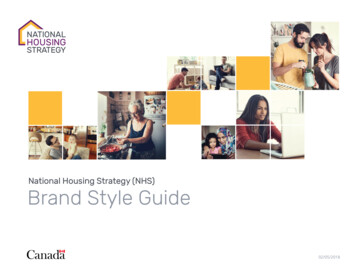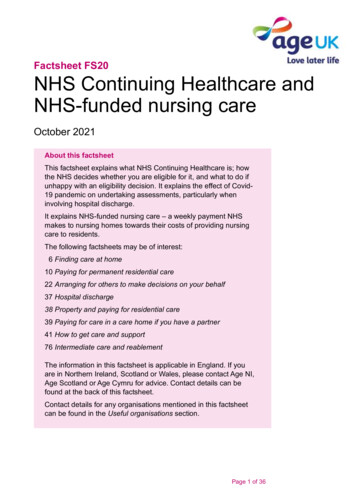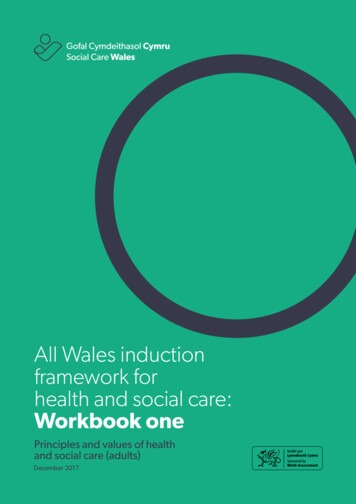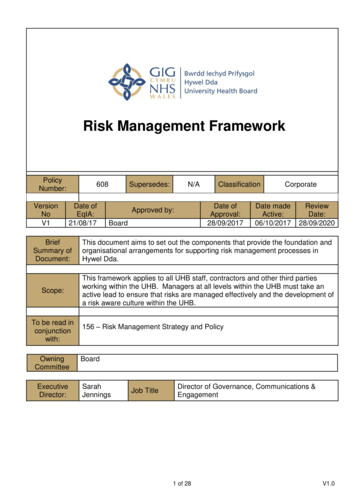
Transcription
Risk Management FrameworkPolicyNumber:VersionNoV1608Date ofEqIA:21/08/17Supersedes:N/AClassificationDate ofApproval:28/09/2017Approved by:BoardCorporateDate mary ofDocument:This document aims to set out the components that provide the foundation andorganisational arrangements for supporting risk management processes inHywel Dda.Scope:This framework applies to all UHB staff, contractors and other third partiesworking within the UHB. Managers at all levels within the UHB must take anactive lead to ensure that risks are managed effectively and the development ofa risk aware culture within the UHB.To be read :156 – Risk Management Strategy and PolicyBoardSarahJenningsJob TitleDirector of Governance, Communications &Engagement1 of 28V1.0
HYWEL DDA UNIVERSITY HEALTH BOARDReviews and updatesVersionno:1Summary of Amendments:DateApproved:New Policy28/09/2017Glossary of termsTermRiskDefinitionThe effect of uncertainty on objectives. Note that an effect may bepositive, negative, or a deviation from the expected. Also, a risk isoften described as an event, a change in circumstance or aconsequence. (ISO Guide 73, 2009)The process which aims to help organisations understand, evaluateand take action on all their risks with a view to increasing theprobability of success and reducing the likelihood of failure. (TheInstitute of Risk Management)Set of components that provide the foundations and organisationalarrangements for designing, implementing, monitoring, reviewingand continually improving risk management processes throughoutthe organization. (ISO Guide 73, 2009)The amount of risk that an organisation is willing to pursue or retain(ISO Guide 73, 2009)The organisation‟s readiness to bear a risk after risk treatment inorder to achieve its objectives. (ISO Guide 73, 2009)The person with the authority and accountability to make thedecision to treat, or not to treat, the risk. (ISO Guide 73, 2009)Generic risk management standard, which provides principles,framework and a process for managing risk, which can be used byany organisation, regardless of size, activity or sectorProvides the definitions of generic terms related to riskmanagement.Risk managementRisk managementframeworkRisk appetiteRisk toleranceRisk ownerISO 31000, 2009ISO Guide 73, 2009KeywordsDatabase No:risk, risk management, RM, risk management framework608VersionPage 2 of 28Risk Management FrameworkPlease check that this is the most up to date version of this written control document1.0
HYWEL DDA UNIVERSITY HEALTH BOARDCONTENTS1.Introduction . 52.Scope . 53.Aim . 54.Risk Management Framework . 55.Risk Management Process . 76.Risk Registers. 76.1. Board Assurance Framework (BAF) . 86.2. Corporate Risk Register (CRR) . 86.3. Project Risk Registers . 97.Risk Architecture. 97.1. The Three Lines of Defence Model . 97.2. Individual Responsibilities . 107.2.1. Chief Executive Officer . 107.2.2. Director of Governance, Communications and Engagement . 107.2.3. Board Secretary . 107.2.4. Head of Assurance & Risk . 107.2.5. Executive Directors . 117.2.6. Managers . 117.2.7. Staff . 127.2.8. Specialist Risk Management Functions. 127.2.9. Independent Members . 127.2.10.Internal Audit . 127.3. Committee Duties & Responsibilities . 137.3.1. The Board . 137.3.2. The Audit and Risk Assurance Committee . 137.3.3. Business Planning & Performance Assurance Committee . 147.3.4. Quality, Safety & Experience Assurance Committee . 147.3.5. Mental Health Legislative Assurance Committee . 157.3.6. University Partnership Board . 157.3.7. Charitable Funds Committee . 157.3.8. Executive Team . 157.3.9. Directorate Risk Management Arrangements . 168.Risk Strategy . 169.Risk Protocols . 1610.Training . 1711.Monitoring and Review of the effectiveness of the Risk Management Framework . 17Database No:608VersionPage 3 of 28Risk Management FrameworkPlease check that this is the most up to date version of this written control document1.0
HYWEL DDA UNIVERSITY HEALTH BOARD12.References . 1713.Appendix 1 – Risk Registers . 1914.Appendix 2 – Executive Risk Ownership. 2015.Appendix 3 – Risk Evaluation . 2116.Appendix 4 – Committee Reporting . 22Database No:608VersionPage 4 of 28Risk Management FrameworkPlease check that this is the most up to date version of this written control document1.0
HYWEL DDA UNIVERSITY HEALTH BOARD1. IntroductionThe Institute of Risk Management defines risk management as ‘the process which aims to helporganisations understand, evaluate and take action on all their risks with a view to increasingthe probability of success and reducing the likelihood of failure’. Risk management hasbecome increasingly more important in recent times because of high profile corporate failuresand increasing stakeholder expectations. As well as supporting better decision making andimproved efficiency, risk management can also provide greater assurance to stakeholders.Any risk management initiative must add value to the organisation, in short, risk managementactivities should be designed to achieve the best possible outcomes and reduce uncertainty ofoutcomes. A successful risk management initiative (and framework) should be: Proportionate to the level of risk within the organisation;Aligned to other business activities;Comprehensive, systematic and structured;Embedded within business procedures and protocols;Dynamic, iterative and responsive to change.In particular, risk management should be embedded into the University Health Board’s (UHB)business and strategic planning and review, change management processes, day to dayoperations and compliance activities.2. ScopeThis framework applies to all UHB staff, contractors, other third parties working within the UHBand those who work in partnership with the UHB. Managers at all levels within the UHB musttake an active lead to ensure that risks are managed effectively and drive the development of arisk aware culture within the UHB.3. AimThis document aims to set out the components that provide the foundation and organisationalarrangements for supporting risk management processes in Hywel Dda.The overall aim of risk management is to: Ensure conformity with applicable rules, regulations and mandatory obligations; Provide assurance to the Board and the Audit and Risk Assurance Committee that riskmanagement and internal control activities are proportionate, aligned, comprehensive,embedded and dynamic; Support decision-making through risk based information; Provide effective and efficient strategy, operations and compliance activities.4. Risk Management FrameworkISO 31000 describes a framework for „implementing‟ risk management, rather than a frameworkto „support‟ the risk management process. The relationship between the principles (reasons) formanaging risk, the framework in which it occurs and the risk management process are shownbelow:Database No:608VersionPage 5 of 28Risk Management FrameworkPlease check that this is the most up to date version of this written control document1.0
HYWEL DDA UNIVERSITY HEALTH BOARD(ISO 31000, 2009)An organisation will describe its framework for supporting risk management by way of the riskarchitecture, strategy and protocols (RASP). This is built around and supports the riskmanagement process. It sets out the roles and responsibilities of the individuals andcommittees that support the risk management process. The risk strategy should set out theobjectives that risk management activities are seeking to achieve, and the risk protocolsdescribe the procedures by which the strategy will be implemented and risks are managed.ISO 31000 (2009)Database No:608VersionPage 6 of 28Risk Management FrameworkPlease check that this is the most up to date version of this written control document1.0
HYWEL DDA UNIVERSITY HEALTH BOARD5. Risk Management ProcessRisk management should be a continuous process that supports the development andimplementation of the strategy of the UHB. It should methodically address all the risksassociated with all the activities of the UHB. This will include identifying the potential for eventsthat constitute threats to success, opportunities for benefit or an increased degree ofuncertainty.The risk management process can be presented as a list of coordinated activities as illustratedbelow:(ISO 31000, 2009)The primary reason for undertaking risk assessment is to ensure that current controls can bevalidated and the need for further actions to improve control of the risk can be identified.Controls are things that the organisation has in place which makes a risk less likely to occur orto mitigate the risk if it does materialise, ie, people, processes, systems, policies, etc.The aim of risk management is not to remove risk altogether but to manage risk to anacceptable level, taking into account the cost of minimising the risk and reducing risk exposure(the level of risk that the organisation is exposed, either in regard to an individual risk or thecumulative exposure to the risks faced by the organisation).6. Risk RegistersThe risk management process is recorded via a risk register. A risk register will provide anagreed record of the significant risks that have been identified through the risk assessmentprocess, ownership of those risks and will also serve as a record of the control activities that arecurrently undertaken. It will also provide a record of the additional actions that are proposed toimprove control of particular risks, including responsibility and timescales for the implementationof those intended controls.A well-constructed and dynamic risk register is at the heart of a successful risk managementinitiative. In order for risk management to be effective and make a significant contribution to theorganisation, the risk register needs to become a document that drives changes andimprovements. Therefore it can sometimes be better to think of the risk register as a „riskmanagement action plan‟.Database No:608VersionPage 7 of 28Risk Management FrameworkPlease check that this is the most up to date version of this written control document1.0
HYWEL DDA UNIVERSITY HEALTH BOARDRisk registers are also used to provide assurance that risks are being managed appropriatelyand effectively. This is undertaken through formal monitoring and scrutiny processes by theUHB‟s Committee structure who will seek assurance on behalf of the Board.Risks can be recorded on 3 different risk registers depending on the type of risk (shown inAppendix 1).6.1. Board Assurance Framework (BAF)The BAF provides a mechanism for managing strategic (principal) risks. The BAF sets outstrategic objectives, identifies risks in relation to each strategic objective and maps out both thekey controls that should be in place to manage those objectives and the sources of assurance(evidence) that these controls are operating effectively. The BAF confirms that agreed actionsare in place to address identified gaps in control or assurance. Additionally, the BAF is crossreferenced with operational risks. The BAF should drive the board agenda.The Executive Team has responsibility to discuss the BAF and any amendments, to ensurethere is appropriate scrutiny and challenge of principal risks prior to the BAF being submitted tothe Board for approval. This will include:1. Review the updates to the existing principal risks since it was last approved by the Board.2. Consider de-escalation of any principal risks to operational risk registers and make thisrecommendation to the Board.3. Agree the submission of any new principal risks to the Board for approval.Although each strategic objective has a lead Executive Director, it is in the interests of theExecutive Team to work collectively to manage these principal risks to ensure that the strategicobjectives delivered within the agreed timescale, thus increasing the UHB‟s probability ofsuccess and reducing likelihood of failure.6.2. Corporate Risk Register (CRR)The CRR is a log of significant risks that emanate from directorate risk registers which couldaffect the day to day operations of the UHB. Appendix 1 shows how operational risks areincluded on service and directorate risk registers and the relationship that exists between these.If operational risks materialise, their impacts tend to have an immediate effect and generallyresult in negative outcomes. The management of these risks usually involves putting in placemeasures to reduce the likelihood of the risk materialising and/or mitigating any potentialimpact, if the risk does materialise.Operational risks should meet the following criteria for inclusion onto the CRR:1. The risk exceeds tolerance level (risk score of 15 or more for 6 months or more) anda) Risk control is not within the directorate‟s influence. This could be for a variety ofreasons such as the risk requiring an enterprise-wide approach in its management(i.e. the involvement of other directorates) or it is beyond its resources to manage, orb) Risk control is not within the UHB‟s influence (ie the UHB does not have directcontrol over the management of the cause of the risk but will be affected by itsimpact if the risk does materialise).In addition, the Executive Team agreed that the Board should be advised of any significantnew/emerging risks, which it considers is outside of the influence of an individual directorate orthe UHB to manage.Database No:608VersionPage 8 of 28Risk Management FrameworkPlease check that this is the most up to date version of this written control document1.0
HYWEL DDA UNIVERSITY HEALTH BOARDThe CRR is reviewed monthly by the Executive Team, who has a pivotal role as a second line ofdefence, to determine risk management strategies for the more challenging risks that threatenthe UHB‟s operations. It is also their role to agree that a risk has been managed to anacceptable level, balancing priorities, resources and the risk to the UHB, and recommend thiscourse of action to the Board. The Board must be provided with assurance that everything thatcan be done, has been done to reduce the risk and that there are effective plans and controls inplace to manage the situation should the risk materialise. This will help limit damage, controlloss and contain costs for the UHB. Whilst a risk may be accepted by the Board, the risk ownermust ensure that the current control measures will be regularly reviewed to ensure they remaineffective. This process is outlined in Appendix 3.6.3. Project Risk RegistersEvery project or programme should have a specific risk register on which risks to that projectcan be reported and managed. Project risk management is concerned with the risks embeddedwithin delivery of the project or programme, ie, delivering the project or programme on time,within budget and within specification, and aims to reduce the variance between anticipatedoutcomes and actual results. A project risk register should be populated and updated regularlythroughout the duration of the project and should help prioritise risk management activity.Significant risks to capital and I&MT projects are reported to the Capital, Estates and I&MT SubCommittee for assurance to be gained on the management of the risks and the delivery ofrelevant projects.7. Risk ArchitectureRisk architecture is the organisational arrangements for risk management detailing the roles,responsibilities and the lines of communication for reporting on risk management.7.1. The Three Lines of Defence ModelThe UHB operates a „Three Lines of Defence‟ model that outlines the principles for the roles,responsibilities and accountabilities for risk management as outlined below:(based on IIA, 2013)Database No:608VersionPage 9 of 28Risk Management FrameworkPlease check that this is the most up to date version of this written control document1.0
HYWEL DDA UNIVERSITY HEALTH BOARDIn the „Three Lines of Defence‟ model, management control is the first line of defence in riskmanagement. The various risk control and compliance oversight functions established bymanagement are the second line of defence, and independent assurance is the third. Each ofthese three “lines” plays a distinct role within the UHB‟s wider governance framework. All threelines need to work interdependently to be effective.Senior management and the Board collectively have responsibility and accountability for settingthe organisation‟s objectives, defining strategies to achieve those objectives, and establishinggovernance structures and processes to best manage the risks in accomplishing thoseobjectives.These roles and responsibilities are further outlined in sections 7.2 & 7.3.7.2. Individual ResponsibilitiesRisk management is the responsibility of all staff. The following sections define theexpectations of particular roles.7.2.1. Chief Executive OfficerThe Chief Executive Officer (CEO), as Accountable Officer, is responsible for systems ofinternal control and implementing the policies set by the Board. The CEO also has overallaccountability for risk management within the UHB and as such is responsible for the annualsigning of the Accountability Report including the Annual Governance Statement, as well asdevolving responsibility for the management of operational risk to relevant Executive Directorsin accordance with the scheme of delegation.7.2.2. Director of Governance, Communications and EngagementThe Director of Governance, Communications and Engagement is the delegated lead for riskmanagement in the UHB and is accountable for leading on the design, development andimplementation of the integrated Board Assurance Framework and Risk ManagementFramework. This includes the following: Producing the UHB Annual Governance Statement; Ensuring the processes and systems for managing governance and compliance are fullytied to the risk register and Board Assurance Framework; Accountable for the Corporate Risk Register, escalation process, tracking of risktolerance levels and developing the organisation‟s risk appetite; Leading the embedding of risk management in the UHB.7.2.3. Board SecretaryThe Board Secretary is responsible for ensuring risk management policies and strategies are inplace to inform planning and decision-making within the UHB and also to oversee the corporaterisk register.7.2.4. Head of Assurance & RiskThe Head of Assurance & Risk is responsible for the development of an effective riskmanagement process and framework. This includes the following: Developing the risk management policy and strategy; Facilitating a risk aware culture within Hywel Dda; Establishing internal risk procedures and guidelines; Co-ordinating risk management activities; Compiling the board assurance framework and the corporate risk register for theBoard;Database No:608VersionPage 10 of 28Risk Management FrameworkPlease check that this is the most up to date version of this written control document1.0
HYWEL DDA UNIVERSITY HEALTH BOARD Ensuring risks are reported, monitored and scrutinised by the Board, committee andsub-committees;Providing training, information and support to staff and managers.7.2.5. Executive DirectorsExecutive Directors have responsibility for the ownership and management of principal(strategic) risks and operational risks within their portfolios (appendix 2). These responsibilitiesinclude Promoting a risk aware culture within their directorate; Signing off risks for inclusion on the corporate risk register; Approving risks emerging from services/departments to be included on the directoraterisk register; Overseeing the co-ordination, updating and validation of risk registers fromservices/departments within their directorate; Establish local arrangements for communicating and monitoring of risks within theirdirectorates; Ensuring that the directorate risk management processes are managed in accordancewith the UHB Framework.Lead Executive Directors, as risk owners, are responsible for managing risks to an acceptablelevel and if this is not possible, to report this to the Board (See Appendix 3).Lead Executive Directors of Board level committees, are also required, with the relevantCommittee Chair, to provide a bi-annual report to the Audit and Risk Assurance Committeewhich provides assurance that risks are being managed appropriately and that the riskmanagement framework and process is effective.7.2.6. ManagersManagers take the lead on risk management and set an example through visible leadership oftheir staff. These responsibilities include: Taking responsibility for managing risk; Ensuring that risks are assessed that are:- Identified within the working activities carried out within their managementcontrol;- Identified within the environment within their control;- Reported from the staff within their management control. Identifying and managing risks that cut across delivery areas; Discussing risks on a regular basis with staff and through discussions at meetings to helpimprove knowledge about the risk faced; increasing the visibility of risk management andmoving towards an action focussed approach.; Ensuring risks are updated regularly and acted upon; Communicating downwards what the top risks are; Reporting risks from the front line. Linking risk to discussions on finance, and stopping or slowing down non-priority areas orprojects to reduce risk as well as staying within budget, demonstrating a real appetite forsetting priorities; Ensuring staff are suitably trained in risk management; Monitoring mitigating actions and ensuring action owners are clear about their roles andwhat they need to achieve;Database No:608VersionPage 11 of 28Risk Management FrameworkPlease check that this is the most up to date version of this written control document1.0
HYWEL DDA UNIVERSITY HEALTH BOARD Ensuring that people are not blamed for identifying and escalating risks, and fostering aculture, which encourages them to take responsibility in helping to manage them;Ensuring that risk management is included in appraisals and development plans whereappropriate;Ensuring the adoption and operation of the risk management framework across theirwork area.7.2.7. StaffAll staff are responsible for: Identifying and reporting hazards, risks and opportunities they may encounter withinthe working activities and environment:- To their manager if the hazard, risk or opportunity is within their department;- To another manager if outside their department. Reporting incidents and near misses; Ensuring visitors and contractors comply with procedures; Contributing to the management of risks and opportunities within the scope of theiractivities and environment.7.2.8. Specialist Risk Management FunctionsThese provide part of the second line of defence in respect of managing risks. The second lineof defence consists of activities covered by several components of internal governance andrelate to a number of functions within the UHB (compliance, risk management, quality, IT andother control departments). They provide the tools, information, knowledge and support to assistthe first line of defence manage risks.This line of defence monitors and facilitates the implementation of effective risk managementpractices by operational management and assists the risk owners in reporting adequate riskrelated information up and down the organisation. These are usually management functionsthat may have some degree of objectivity, but are not entirely independent from the first line.7.2.9. Independent MembersIndependent Members have an important role in risk management within the UHB. This role isrestricted to seeking assurance on the robustness of processes and the effectiveness ofcontrols through constructive, robust and effective challenge to Executive Directors and seniormanagement. It is not appropriate for Independent Members to be involved in the managementof individual risks, but to understand and question risk on an informed and ongoing basis.Additionally, Independent Members chair Board level committees, and in line with the relevantcommittee Terms of Reference, should provide assurance to the Board that risks within its remitare being managed effectively by the risk owners, and report any areas of concern, to theBoard. Committee Chairs, with the Lead Executive Director, are also required to provide a biannual report to the Audit and Risk Assurance Committee to provide assurance that risks arebeing managed appropriately by risk owners and that the risk management framework andprocess remains effective.7.2.10.Internal AuditThe relationship between risk management and Internal Audit is critically important. Riskmanagement is concerned with the assessment of risk and the identification of existing andadditional controls whereas it is Internal Audit‟s role to evaluate these controls and test theirDatabase No:608VersionPage 12 of 28Risk Management FrameworkPlease check that this is the most up to date version of this written control document1.0
HYWEL DDA UNIVERSITY HEALTH BOARDefficiency and effectiveness. This is undertaken through Internal Audit programme of work.Accordingly, the Head of Internal Audit will: Provide an overall opinion each year to the Accountable Officer of the organisation‟s riskmanagement, control and governance, to support the preparation of the AnnualGovernance Statement;Focus the internal audit work on the significant risks, as identified by management, andauditing the risk management processes across the organisation;Audit of the organisation‟s risk management, control and governance through operationalaudit plans in a way which affords suitable priority to the organisation‟s objectives andrisks;Provide assurance on the management of risk and improvement of the organisation‟s riskmanagement, control and governance by providing line management withrecommendations arising from audit work.7.3. Committee Duties & ResponsibilitiesEffective risk management requires a reporting and review structure to ensure that risks areeffectively identified and assessed and that appropriate controls and responses are in place.Appendix 4 sets out the sets out the process for monitoring risks through Board & CommitteeStructure.7.3.1. The BoardThe Board maintains overall accountability for effective risk management, and will haveresponsibility for the following key duties: Appr
4. Risk Management Framework ISO 31000 describes a framework for „implementing‟ risk management, rather than a framework to „support‟ the risk management process. The relationship between the principles (reasons) for managing risk, the framework in which it occurs and the risk management process are shown below:

